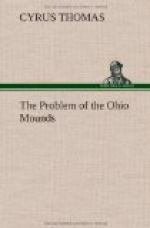Fourth. Reasons for believing that the Cherokees were the Tallegwi of tradition and the authors of some of the typical works of Ohio.
CHAPTER I.
The historical evidence.
Space will not permit any review here of the various theories in regard to the builders, or of the objections made to the theory that they were Indians, or of the historical evidence adducible in support of this theory. Simple declaration on these points must suffice.
The historical evidence is clear and undisputed that when the region in which the mounds appear was discovered by Europeans it was inhabited by Indians only. Of their previous history nothing is known except what is furnished by vague and uncertain traditions or inferred from the study of their languages and customs. On the other hand there is no historical or other evidence that any other race or people than the Indians ever occupied this region, or any part of it, previous to its discovery by Europeans at the close of the fifteenth century.
We enter the discussion, therefore, with at least a presumption in favor of the conclusion that these works were built by the Indians—a presumption which has not received the consideration it deserves; indeed, it is so strong that it can be overcome only by showing that those mounds, or the specimens of art found in them, which were unquestionably the work of the builders, indicate an advancement in skill and knowledge entirely beyond that reached by the Indians previous to contact with Europeans. But all the genuine discoveries so far made in the explorations of the mounds tend to disprove this view.
If it can be shown that tribes occupying the mound region at the time they were first visited by Europeans used mounds, and in some cases built them, it will be a fair inference that all these structures are due to the same race until the contrary is proved.
The objection urged by many that the Indian has always been a restless nomad, spurning the restraints of agriculture, has been effectually answered, especially by Mr. Lucien Carr. [Footnote: Mounds of the Mississippi Valley Historically Considered.] History also bears us out in the assertion that at the time of the discovery nine tenths of the tribes in the mound district had fixed seats and local habitations, depending to a great extent for sustenance upon the cultivation of the soil. So far as the southern districts, now comprising the Gulf States, are concerned, it goes further and asserts over and over again that the tribes of that section were mound-builders when first encountered by the whites. To verify this assertion it is only necessary to read the chronicles of De Soto’s expedition and the writings of the pioneer travelers and French missionaries to that section. This evidence proves conclusively not only that this had been a custom, but that it was continued into the eighteenth century.




